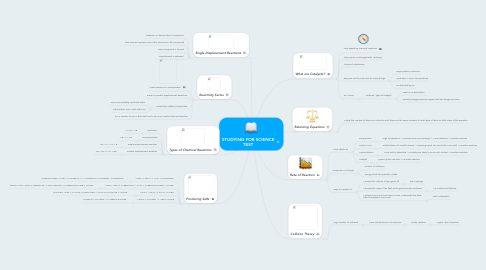
1. Types of Chemical Reactions
1.1. Synthesis
1.1.1. A + B -> AB
1.2. Decomposition
1.2.1. AB -> A + B
1.3. Single Displacement Reaction
1.3.1. AB + C -> AC + B
1.4. Double Displacement Reaction
1.4.1. AB + CD -> AC + BD
2. Producing Salts
2.1. ACID + METAL -> SALT + HYDROGEN
2.1.1. HYDROCHLORIC ACID + MAGNESIUM -> MAGNESIUM CHLORIDE + HYDROGEN
2.2. ACID + METAL CARBONATE -> SALT + CARBON DIOXIDE + WATER
2.2.1. NITRIC ACID + ZINC CARBONATE -> ZINC NITRATE + CARBON DIOXIDE + WATER
2.3. ACID + ALKALI -> SALT + WATER
2.3.1. SULFURIC ACID + CALCIUM HYDROXIDE -> CALCIUM SULFATE + WATER
2.4. METAL + OXYGEN -> METAL OXIDE
2.4.1. CARBON + OXYGEN -> CARBON DIOXIDE
3. Reactivity Series
3.1. Least Reactive to Most Reactive
3.2. Easier to predict Displacement Reactions
3.3. Metals have different reactivities
3.3.1. Some immediately react with water
3.3.2. Others don't even react with acid
3.4. For a reaction to occur the metal has to be more reactive than salt solution
4. Single Displacement Reactions
4.1. Between an element and a compound
4.2. Free element replaces one of the elements in the compound
4.3. New compound is formed
4.4. New element is released
5. Balancing Equations
5.1. Adjust the number of atoms or molecules until there are the same numbers of each type of atom on both sides of the equation.
6. Rate of Reaction
6.1. What affects it?
6.1.1. Temperature
6.1.1.1. High temperature -> Particles have more energy -> More collisions -> Quicker reaction
6.1.2. Surface Area
6.1.2.1. Solid broken into smaller pieces -> Reacting liquid can react with more solid -> Quicker Reaction
6.1.3. Concentration
6.1.3.1. More solid is dissolved -> Particles are likely to come into contact -> Quicker Reaction
6.1.4. Catalyst
6.1.4.1. Speed up the reaction -> Quicker Reaction
6.2. Depends on 2 things:
6.2.1. number of collisions
6.2.2. energy which the particles collide
6.3. Ways to measure it:
6.3.1. Measure the volume of gas given off
6.3.1.1. with a syringe
6.3.2. Measure the mass of the flask while gas leaves the container
6.3.2.1. on a electronic balance
6.3.3. Measure how much time does a cross, underneath the flask, take to disappear from view.
6.3.3.1. with a stopwatch
7. Collision Theory
7.1. High number of collisions
7.1.1. More combinations of molecules
7.1.1.1. Faster reaction
7.1.1.1.1. Higher rate of reaction
8. What are Catalysts?
8.1. Help speed up chemical reactions
8.2. They remain unchanged after "helping"
8.3. Chemical Substances
8.4. Enzymes are the same but for living things
8.4.1. Large protein molecules
8.4.2. Work best in warm temperatures
8.4.3. Are affected by pH
8.5. EXAMPLE:
8.5.1. Platinum ( type of catalyst)
8.5.1.1. Used in car exhausters
8.5.1.2. Quickly change poisonous gases into less dangerous ones
